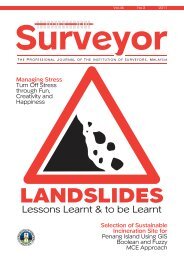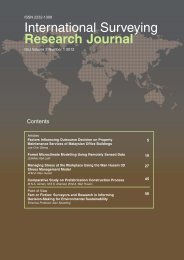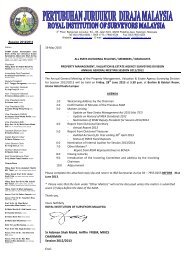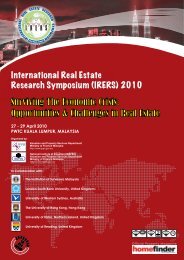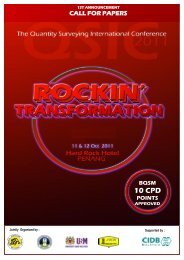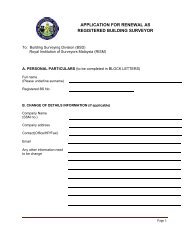Full 46.1 - Royal Institution of Surveyors Malaysia
Full 46.1 - Royal Institution of Surveyors Malaysia
Full 46.1 - Royal Institution of Surveyors Malaysia
You also want an ePaper? Increase the reach of your titles
YUMPU automatically turns print PDFs into web optimized ePapers that Google loves.
THE MALAYSIAN SURVEYOR | Vol.46 | No.1 | 2011<br />
INTERNAL RATE OF RETURN:<br />
UNDERSTANDING THE<br />
DIFFERENCE BETWEEN<br />
IRR, MIRR AND FMRR<br />
James Kobzeff<br />
Internal rate <strong>of</strong> return (IRR), modified internal rate <strong>of</strong> return (MIRR), and financial<br />
management rate <strong>of</strong> return (FMRR) are three returns used to measure the pr<strong>of</strong>itability<br />
<strong>of</strong> investment property. Each method arrives at a percentage rate based upon an initial<br />
investment amount and future cash flows, and in each case (<strong>of</strong> course) the higher the<br />
better, but the procedure for making the calculation varies significantly as do the results.<br />
By definition, internal rate <strong>of</strong> return is<br />
the discount rate at which the present value <strong>of</strong><br />
all future cash flows is exactly equal to the initial<br />
capital investment. To make the calculation,<br />
negative cash flows are discounted at the same rate (i.e.,<br />
the IRR) as positive cash flows.<br />
Let’s consider the following investment with the initial<br />
investment as CF0 (always a negative number because it<br />
is cash outflow) and subsequent cash flows as CF1, CF2,<br />
etc., with some negative and some positive.<br />
CF0 -10,000<br />
CF1 -100,000<br />
CF2 50,000<br />
CF3 -60,000<br />
CF4 50,000<br />
CF5 249,300<br />
IRR = 30%<br />
Seems all well and good, but the problem here is that the<br />
calculation assumes that the cash generated during an<br />
investment will be reinvested at the rate calculated by the<br />
IRR, which may be unrealistically high and therefore will<br />
overstate the return on initial investment. Likewise, since<br />
negative cash flows are also discounted at the IRR, if that<br />
rate is fairly high, the investor might not accurately<br />
estimate the cash required to meet those future negative<br />
cash flows.<br />
To deal with this shortcoming many real estate analysts<br />
use a method known as MIRR (i.e., modified internal rate<br />
<strong>of</strong> return). In this approach, the assumption is that<br />
positive cash flows the investment generates during its<br />
life can be reinvested and earns interest at a<br />
“reinvestment rate”, and negative cash flows must be<br />
financed at a “finance rate” during the life <strong>of</strong> the<br />
investment. In other words, rather than simply using one<br />
rate (i.e., IRR) to deal with both negative and positive<br />
cash flows, MIRR introduces the option to use two<br />
different rates.<br />
By applying a finance rate <strong>of</strong> 5% and a reinvestment rate<br />
<strong>of</strong> 10% here’s the result using the same investment<br />
criteria as we did earlier.<br />
48




